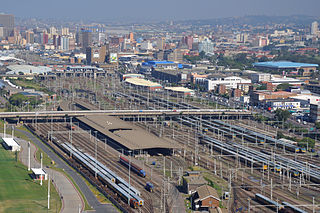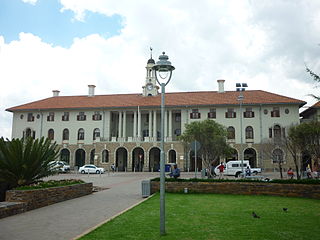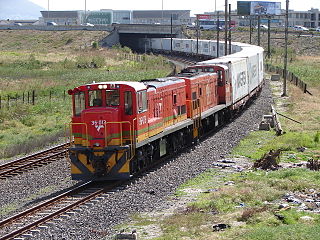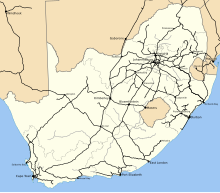Different methods of transportation in South Africa include roads, railways, airports, and water. Most people in South Africa use informal minibus taxis as their primary mode of transport. BRT, a bus service, has been implemented in some South African cities to provide more formalised and safer public transport services. These systems have been criticised due to their significant capital and operating costs. South Africa has many major ports, including Cape Town, Durban, and Port Elizabeth.

The National Railways of Zimbabwe (NRZ), formerly Rhodesia Railways (RR), is a Bulawayo headquartered state-owned enterprise that operates the country's national railway system. It was established in 1893 and governed by an Act of Parliament. It has a commercial-administrative center in Harare and a supply center in Gweru. The Zimbabwean railway system was largely constructed during the 20th century.

The Blue Train travels an approximately 1,600-kilometre (990 mi) journey in South Africa between Pretoria and Cape Town. It is one of the most luxurious train journeys in the world. It boasts butler service, two lounge cars, an observation car, and carriages with gold-tinted picture windows, in soundproofed, fully carpeted compartments, each featuring its own en-suite. The service is promoted as a "magnificent moving five-star hotel" by its operators, who note that kings and presidents have travelled on it.

Metrorail is an operator of commuter rail services in the major urban areas of South Africa. It is a division of the Passenger Rail Agency of South Africa (PRASA), a state-owned enterprise which is responsible for most passenger rail services in South Africa. The Metrorail system consists of 471 stations, 2,228 kilometres (1,384 mi) of track, and carries an average of 1.7 million passengers per weekday.

Shosholoza Meyl is a division of the Passenger Rail Agency of South Africa (PRASA) that operates long-distance (intercity) passenger rail services. It operates various train routes across South Africa, carrying approximately 4 million passengers annually. Before 2009, Shosholoza Meyl was a division of Spoornet, but it was transferred after the formation of PRASA.

Transnet Freight Rail is a South African rail transport company, formerly known as Spoornet. It was part of the South African Railways and Harbours Administration, a state-controlled organisation that employed hundreds of thousands of people for decades from the first half of the 20th century and was widely referred to by the initials SAR&H. Customer complaints about serious problems with Transnet Freight Rail's service were reported in 2010. Its head office is in Inyanda House in Parktown, Johannesburg.

Cape Town railway station is the main railway station of the city of Cape Town, South Africa. It is located along Adderley and Strand Streets in the city's central business district.

The Passenger Rail Agency of South Africa (PRASA) is a South African state-owned enterprise responsible for most passenger rail services in the country.

Bellville mainline railway station is a railway station in the town of Bellville, Western Cape, South Africa. It is the second-biggest station in the Metrorail Western Cape railway network, after the Cape Town terminus. All trains on Metrorail's Northern Line pass through Bellville, and one branch of the Central Line also terminates there. It is also a stop for Shosholoza Meyl trains that terminate in Cape Town.
Port Elizabeth railway station is a railway station, located in Port Elizabeth, South Africa.

Johannesburg Park Station is the central railway station in the city of Johannesburg, South Africa, and the largest railway station in Africa. It is located between the Central Business District and Braamfontein, in the block bordered by Rissik, Wolmarans, Wanderers, and Noord Streets. Park Station lies on the main Witwatersrand railway line that runs East-West from Krugersdorp to Germiston. The first four stations to the east are Doornfontein, Ellis Park, Jeppe and George Goch Stations.

Durban railway station is the central railway station in the city of Durban, South Africa, located between Umgeni Road and Masabalala Yengwa Avenue just to the north of the central business district. It is the terminus of Shosholoza Meyl long-distance services from Johannesburg and Cape Town, and the hub of a network of Metrorail commuter rail services that stretch as far as KwaDukuza (Stanger) to the north, Kelso to the south, and Cato Ridge inland.

Pretoria railway station is the central station in Pretoria, the executive capital of South Africa. It is located between Pretoria's central business district and Salvokop, in a 1910 building designed by Herbert Baker. It is the terminus of various Metrorail commuter rail services in the northern part of Gauteng, and a stop on Shosholoza Meyl inter-city services from Johannesburg to Polokwane and Nelspruit. Pretoria is also the northern terminus of the luxury Blue Train service from Cape Town. Platforms and tracks for the Gautrain rapid-rail service are adjacent to the main-line station.

East London railway station is the central railway station in the city of East London in the Eastern Cape province of South Africa. It is the terminus for Shosholoza Meyl inter-city trains to Johannesburg and Cape Town, and of a Metrorail commuter service to Mdantsane and Berlin.

The South African Railways Class 6E1, Series 4 of 1973 was an electric locomotive.

The South African Railways Class 12E of 1983 was an electric locomotive.

The South African Railways Class 35-200 of 1974 is a diesel-electric locomotive.

The South African Railways Class 36-000 is a diesel-electric locomotive.

The Passenger Rail Agency of South Africa Class Afro 4000 of 2014 is a South African diesel-electric locomotive.
Autopax is a holding company of two South African intercity bus services and is a wholly owned subsidiary of Passenger Rail Agency of South Africa (Prasa). Its mandate is to provide long distance inter-city and charter services as well bus services crossing borders in Southern Africa via the use of luxury, semi-luxury and intercity coaches.





















